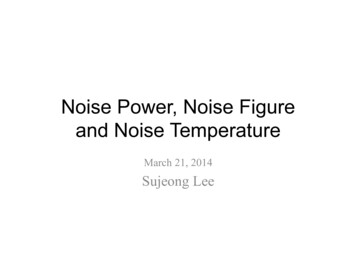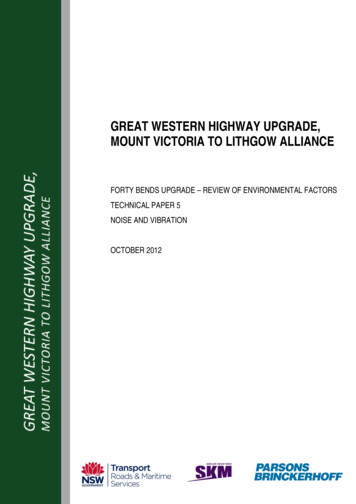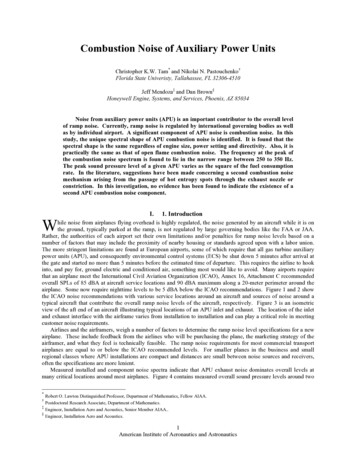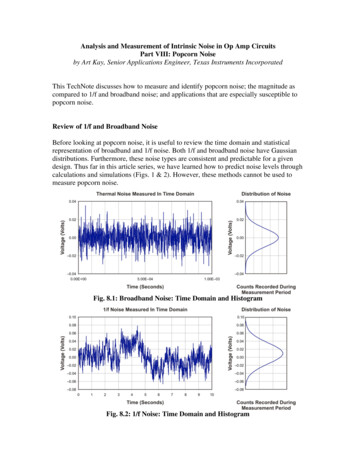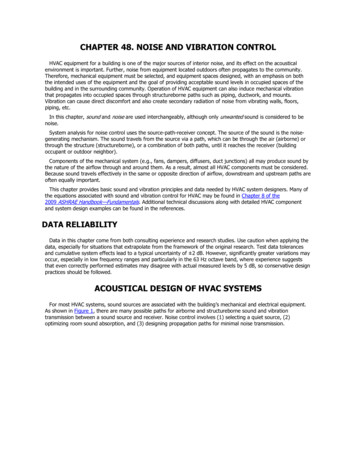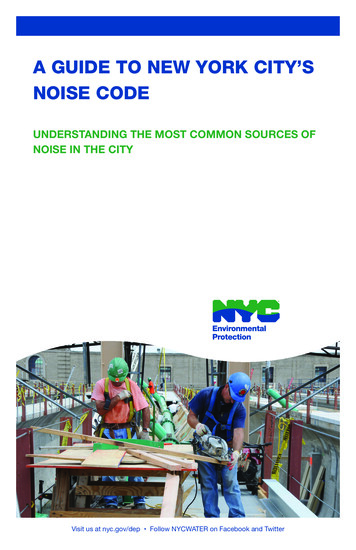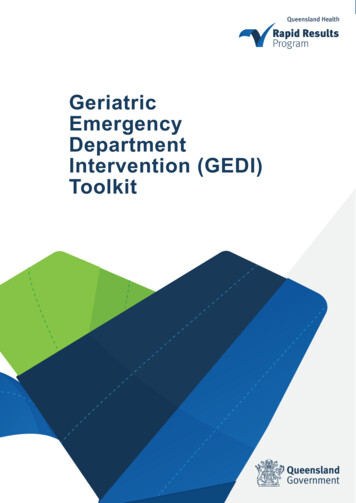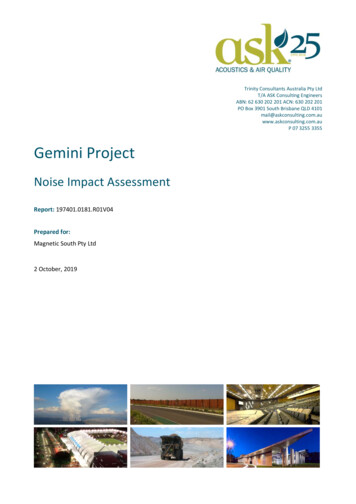
Transcription
Trinity Consultants Australia Pty LtdT/A ASK Consulting EngineersABN: 62 630 202 201 ACN: 630 202 201PO Box 3901 South Brisbane QLD .auP 07 3255 3355Gemini ProjectNoise Impact AssessmentReport: 197401.0181.R01V04Prepared for:Magnetic South Pty Ltd2 October, 2019
Document ControlDocument RefDate of IssueStatusAuthorReviewer197401.0181.R01V01 draft6 September, 2019DraftTim OsborneGillian Adams197401.0181.R01V0126 September, 2019FinalTim OsborneGillian Adams197401.0181.R01V0226 September, 2019Updated FinalTim OsborneGillian Adams197401.0181.R01V0330 September, 2019Updated FinalTim OsborneGillian Adams197401.0181.R01V042 October, 2019Updated FinalTim OsborneGillian AdamsDocument ApprovalApprover SignatureNameGillian AdamsTitlePrincipal EngineerDisclaimer: This document and associated tasks were undertaken in accordance with the ASK Consulting EngineersQuality Assurance System, which is based on Australian Standard / NZS ISO 9001:2008. This document is issuedsubject to review, and authorisation by a Senior Consultant noted in the above table. If the table is incomplete, thisdocument shall be considered as preliminary or draft only and no reliance shall be placed upon it other than forinformation to be verified later.This document is prepared for our Client's particular requirements which are based on a specific brief with limitationsas agreed to with the Client. It is not intended for and should not be relied upon by a third party and no responsibilityis undertaken to any third party without prior consent provided by ASK Consulting Engineers. The information hereinshould not be reproduced, presented or reviewed except in full. Prior to passing on to a third party, the Client is tofully inform the third party of the specific brief and limitations associated with the commission.The information contained herein is for the identified purpose of acoustics only. No claims are made and no liabilityis accepted in respect of design and construction issues falling outside of the specialist field of acoustics engineeringincluding and not limited to structural integrity, fire rating, architectural buildability and fit-for-purpose,waterproofing, safety design and the like. Supplementary professional advice should be sought in respect of theseissues.Copyright: This report and the copyright thereof are the property of Trinity Consultants Australia Pty Ltd T/A ASKConsulting Engineers (ABN 62 630 202 201). It must not be copied in whole or in part without the written permissionof Trinity Consultants Australia Pty Ltd. This report has been produced specifically for the Client and projectnominated herein and must not be used or retained for any other purpose. www.askconsulting.com.au197401.0181.R01V042
Contents1.Introduction52.Study Area Description63.Proposed Development83.1Project Description83.2Projected Equipment Numbers94.Existing Noise Environment114.1Overview and Locations114.2Weather114.3Attended Noise Measurements114.4Noise Logging12Acoustic Criteria145.1Overview145.2Environmental Protection Act145.3Environmental Protection (Noise) Policy145.4OverviewAcoustic Quality ObjectivesBackground CreepGuideline – Planning for Noise Control141515155.5Guideline – Noise & Vibration from Blasting165.6Proposed Criteria165.5.3.15.3.25.3.35.6.15.6.26.Noise EmissionsBlastingNoise Assessment1616176.1Model Description176.2Meteorology176.3Noise Source Data176.4Modelling Scenarios186.5Predicted Noise Levels & Assessment196.6Discussion & Recommendations226.6.16.6.27.Noise Monitoring, Management & MitigationCumulative Noise ImpactsBlasting Ground Vibration197401.0181.R01V04243
dicesAppendix AGlossary28Appendix BNoise Monitoring Photos30Appendix CNoise Monitoring Results33Appendix DMining Equipment Locations38Appendix EPredicted Mining Noise Contours41197401.0181.R01V044
1.IntroductionASK Consulting Engineers (ASK) was commissioned by Magnetic South Pty Ltd to provide a noise and vibrationimpact assessment for the Gemini Project.The Gemini Project consists of a greenfield open cut mine to produce Pulverised Coal Injection (PCI) coal andCoking Coal products for export for steel production. The Project is located within EPC 881 and the proposedMining Lease Application (MLA) boundary in the Bowen Basin, Central Queensland. The site is locatedapproximately 15 km east of Bluff and 3 km west of Dingo. The site location and surrounds are shown inFigure 1.1.Jellinbah MineCurragh East MineBlackwaterBluffDingoBluff MineGemini ProjectBlackwater Mine20 kmFigure 1.1Site Location & SurroundsThe purpose of this report is as follows: Present the results of noise monitoring data of the existing environment at selected sensitivereceptors. Propose appropriate noise and vibration criteria. Determine noise emission levels from the proposed fixed and mobile plant. Determine airblast and vibration levels due to blasting operations. Assess noise and vibration impacts for three scenarios of mining operations under adverse and neutralmeteorological conditions in accordance with the nominated noise and vibration criteria.To aid in the understanding of the terms in this report a glossary is included in Appendix A.197401.0181.R01V045
2.Study Area DescriptionThe Gemini Project is located approximately 3 km west of Dingo.The nearest residential sensitive receptors are summarised in Table 2.1.Table 2.1SensitiveReceptor 32Sensitive ReceptorsReceptor typeResidentialResidentialResidentialResidential, facilities(sports oval, tenniscourt, school) &businesses (PostOffice, hotel, shops,sawmills, tialResidentialResidentialResidentialResidential identialReal PropertyDescriptionEasting (m)Northing 9377386940738232873820774.9 km W3.2 km E4.3 km 5737758173777004.2 km WWithin MLA1.4 km E2.4 km E2.5 km S0.3 km N3.0 km NE3.8 km WWithin MLA1.4 km SE1.4 km SE1.4 km SE100RP8823497264997386357Within 57437386813Within MLA1.2 km NE5.1 km E4.5 km E4.4 km E4.6 km E1.1 km NW1.2 km NW3.0 km EIt is noted that SR07 represents the Dingo township. The following sensitive receptors are located within theMining Lease Application (MLA) Area: SR09 SR18 SR23At the time of report preparation, Magnetic South is the landowner of the property 3HT139, on whichsensitive receptor 14 is located, and Lot 2, HT138, on which sensitive receptors SR19, SR20 and SR21 arelocated. Discussions between Magnetic South and landowners of properties located within the MLA areongoing.197401.0181.R01V046
The Capricorn Highway and the Blackwater-Gladstone rail network extend through the northern section ofthe MLA. A number of the sensitive receptors are located within 1 km of the highway and rail line.The site location and sensitive receptors are shown in Figure 2.1.Figure 2.1Site Location (MLA shown with brown line) & Sensitive ReceptorsAccording to the Department of Natural Resources, Mines and Energy’s MinesOnlineMaps system, thenearest mine to the Gemini Project is Bluff Mine, which is located approximately 15 km west of the GeminiProject’s proposed ROM pad. There are a number of other mines further to the west, but no other mineswithin 50 km to the north, south or east.197401.0181.R01V047
3.Proposed Development3.1Project DescriptionThe Gemini Project is a greenfield, open-cut metallurgical coal mine producing Pulverised Coal Injection (PCI)coal and coking coal for export to the international steel making industry. The Project term is anticipated tobe 25 years from grant of the Mining Lease (ML) with this term including initial construction, mine operationand rehabilitation activities.Mine construction activities are scheduled to commence in July 2021 subject to granting of the Project MLand EA. It is anticipated that it will take approximately six months to establish the necessary infrastructureto commence overburden removal and 18 months to commence coal production.The main activities associated with the Project include: Exploration activities continuing in order to support mine planning Development of a Mine Infrastructure Area (MIA) including mine offices, bathhouse, crib rooms, warehouse/stores, workshop, fuel storage, refuelling facilities, wash bay, laydown area, sewage,effluent and liquid waste storage, and a heli-pad.Construction and operation of a Coal Handling Preparation Plant (CHPP) and coal handling facilitiesadjacent to the MIA (including Run-of-Mine (ROM) coal and product stockpiles, and rejectsbin/overflow [coarse and fine rejects]).Construction and operation of a surface conveyor from the product stockpiles to a Train Load Out (TLO)facility and rail loop connecting to the Blackwater-Gladstone Branch Rail to transport product coal tocoal terminals at Gladstone for export.Construction of access roads from the Capricorn Highway to the MIA, and from the accommodationfacility to the TLO facility.Installation of a raw water supply pipeline to connect to the Blackwater Pipeline network.Construction of a 66 kV transmission line and switching/substation to connect to the existing regionalnetwork.Other associated minor infrastructure, plant, equipment and activities.Development of mine areas (open cut pits) and out-of-pit waste rock emplacements.Drilling and blasting of competent waste material.Mine operations using conventional surface mining equipment (excavators, front end loaders, reardump trucks, dozers).Mining up to 1.9 Mtpa ROM Coal – average 1.8 Mtpa for a construction/production period ofapproximately 20 years.Progressive placement of waste rock in:Emplacements, adjacent to and near the open cut voids.Mine voids, behind the advancing open cut mining operations.Progressive rehabilitation of waste rock emplacement areas and mined voids.Progressive establishment of soil stockpiles, laydown area and borrow pits (for road base and civilworks). Material will be sourced from local quarries where required.Disposal of CHPP rejects (coarse and fine rejects) in out of pit spoil dumps, and in-pit behind the miningvoid.Progressive development of internal roads and haul roads including a causeway over Charlevue Creekto enable coal haulage and pit access.197401.0181.R01V048
Development of water storage dams and sediment dams, and the installation of pumps, pipelines, andother water management equipment and structures including temporary levees, diversions and drains.The proposed mine layout is shown in Figure 3.1.Figure 3.1Proposed Mine Layout3.2Projected Equipment NumbersTo give an indication of the amount of equipment used, the proposed haul truck numbers for the open cutmining operations are presented in Table 3.1.Table 3.1Haul Truck Fleet in Each Mining YearMining YearWaste Haul TrucksCoal Haul 2197401.0181.R01V049
Mining YearWaste Haul TrucksCoal Haul Trucks1213141516171819151515171717171022233333It is noted that these haul truck numbers are the actual number of trucks in use at any one time, with anadditional number of trucks being out of operation for maintenance etc. Further details on the types andnumbers of equipment are provided in Section 6.4.The major items of equipment at the ROM pad include a Coal Handling Preparation Plant (CHPP) and a frontend loader (FEL). The rail loadout facility is also included in the model, including conveyors, conveyor drives,rail loadout bin and train locomotives.197401.0181.R01V0410
4.Existing Noise Environment4.1Overview and LocationsAttended noise measurements and noise logging were undertaken at the following locations: Location A – Accommodation Facility: Located in an open-field, approximately 360 metres northeastof the railway line and 440 metres northeast of the Capricorn highway (726505.61 E, 7386445.61 N).This is the same location as SR22 (refer Figure 2.1). Location B – Roadhouse: Located in an open-field location, approximately 220 metres southwest ofthe Capricorn Highway (738095.59 E, 7382329.42 N). This is approximately the same location as SR03(refer Figure 2.1). Location C – Residence: Located in an open-field position, approximately 200 metres northeast of thehomestead (732865.98 E, 7377627.44 N). This is approximately the same location as sensitivereceptors S19, SR20 and SR21 (refer Figure 2.1).Aerial photos of the measurement locations are included in Figures B.1, B.2 and B.3 in Appendix B.The noise monitoring was undertaken in general accordance with Australian Standard AS1055 Acoustics –Description and measurement of environmental noise and the DES Noise Measurement Manual 2013.4.2WeatherData from the Bureau of Meteorology (Blackwater Airport) indicates that weather for the duration of thenoise monitoring period was generally fine and warm with rainfall only recorded for Saturday 08/06/2019(16.6 mm), Sunday 09/06/2019 (5.4 mm) and Tuesday 11/06/2019 (0.2 mm). Overall, the noise monitoringdata has been deemed acceptable for use in this report.4.3Attended Noise MeasurementsAttended noise measurements were undertaken at Locations A, B and C. The measurements wereundertaken over separate 15-minute periods using a field and laboratory calibrated Larson Davis LD831sound level meter. The microphone height was approximately 1.5m above natural ground level and waslocated in the free field at each location. Weather during the time of monitoring was generally cool, calmand clear. The conditions were as follows: Daytime: Approximately 11 to 15 C with a 2 to 3 m/s breeze and 1/8 cloud cover. Night time: Approximately 8 to 10 C, with a 0 to 3 m/s breeze and 1/8 cloud cover.The measured noise levels are summarised in Table 4.1.197401.0181.R01V0411
Table 4.1Attended Noise Measurement ResultsLocationDate & TimePeriod(Minutes)Results & NotesA19/06/201915Statistical noise levels: L10 61 dBA, Leq 55 dBA, L90 21 dBA11:39pmCoal trains: 54 to 66 dBATrain horn: 58 dBADistant cattle noise: 24 to 27 dBACapricorn highway traffic: 45 to 52 dBAB19/06/20191510:03pmStatistical noise levels: L10 61 dBA, Leq 56 dBA, L90 36 dBACoal trains: 53 to 64 dBATrain horn: 78 to 79 dBACapricorn highway traffic: 30 to 61 dBAC19/06/20191510:52pmStatistical noise levels: L10 27 dBA, Leq 27 dBA, L90 19 dBACattle noise (Distant): 21 to 33 dBACattle noise (Closer): 37 to 43 dBABirds: 33 dBAA20/06/20191508:16amStatistical noise levels: L10 53 dBA, Leq 50 dBA, L90 41 dBABirds: 39 to 42 dBAHighway trucks: 47 to 56 dBACapricorn highway traffic: 37 to 50 dBAB20/06/20191509:38amStatistical noise levels: L10 51 dBA, Leq 49 dBA, L90 46 dBAWind through trees/rustling leaves: 47 to 48 dBACrows: 54 to 58 dBABirds: 46 to 51 dBATruck leaving parking area: 47 to 55 dBACapricorn highway traffic: 45 to 53 dBANote: * The reported noise levels, excluding the statistical noise levels, are the instantaneous levels read from thesound level meter, and generally represent the range in noise levels or maximum noise levels for a particularnoise source.4.4Noise LoggingNoise logging was undertaken over the following time periods: Location A – Accommodation Facility: The measurement period was Friday 7th to Wednesday 19th June2019. Location B – Roadhouse: The measurement period was Friday 7th to Wednesday 19th June 2019. Location C – Residence: The measurement period was Friday 7th to Monday 17th June 2019.Logging was undertaken using field and laboratory calibrated Larson Davis LD831 environmental noiseloggers. Noise logging was undertaken in the free-field at each location.The measured noise levels at Locations A, B and C are shown in Figure C.1 to C.6 in Appendix C. The statisticalresults from the noise logging have been summarised in Tables C.1, C.2 and C.3 in Appendix C.The noise logger at Location C had its wind protector removed when the logger was collected. This couldhave adversely affected the results with wind noise resulting in increased noise levels. However, thebackground noise levels remained consistently low throughout the measurement period, including197401.0181.R01V0412
background noise levels below 20 dBA L90, and therefore the background noise data is still considered to beof use for this review.The background noise levels were affected by insect noise at Locations A and C. At Location B, insect noisewas minimal. As the insect noise is likely a seasonal influence, the noise level data has been filtered to removethe insect noise from Location A and C. The resulting background noise levels, calculated using the lowest10th percentile method, are shown in Table 4.2.Table 4.2Background Noise Level with Insect Noise RemovedPeriodBackground Noise Level (Less Insect Noise) L90 dBALocation ALocation BLocation CDay (7am to 6pm)333525Evening (6pm to 10pm)233729Night (10pm to 7am)202722197401.0181.R01V0413
5.Acoustic Criteria5.1OverviewNoise and vibration criteria are required to assess the potential impacts of the proposed Gemini Projectoperations on sensitive receptors.The relevant Department of Environment and Science (DES) noise and vibration criteria have been consideredand are listed as follows: Environmental Protection Act 1994 Environmental Protection (Noise) Policy 2019 Guideline “Planning For Noise Control” Guideline “Noise and Vibration from Blasting”5.2Environmental Protection ActIn Queensland, the environment is protected under the Environmental Protection Act 1994 (EP Act).Section 3 of the EP Act states that the object of the Act is to protect Queensland’s environment while allowingfor development that improves the total quality of life, both now and in the future, in a way that maintainsthe ecological processes on which life depends (ecologically sustainable development).Section 12 of the EP Act defines noise as including “vibration of any frequency, whether emitted through airor another medium” and thus includes underwater noise.Section 319 of the EP Act relates to General Environmental Duty and states that a person must not carry outany activity that causes, or is likely to cause, environmental harm unless the person takes all reasonable andpracticable measures to prevent or minimise the harm.Section 14(1) of the EP Act defines environmental harm as any adverse effect, or potential adverse effect(whether temporary or permanent and of whatever magnitude, duration or frequency) on an environmentalvalue, and includes environmental nuisance.Section 15 of the EP Act defines environmental nuisance as an unreasonable interference or likelyinterference with an environmental value caused by (a) . noise.Section 440 of the EP Act relates to the offence of causing a nuisance, and section 440Q relates to the offenceof contravening a noise standard. In both cases, the sections state it does not apply to an environmentalnuisance of the variety mentioned in schedule 1, part 1 of the EP Act.The EP Act refers to the Environmental Protection Policies as being subordinate legislation to the Act.5.3Environmental Protection (Noise) Policy5.3.1OverviewIn respect of the acoustic environment, the object of the Act is achieved by the Environmental Protection(Noise) Policy 2019 (EPP (Noise)). This policy identifies environmental values to be enhanced or protected,states acoustic quality objectives, and provides a framework for making decisions about the acousticenvironment.197401.0181.R01V0414
5.3.2Acoustic Quality ObjectivesThe EPP (Noise) contains a range of acoustic quality objectives for a range of receptors. The objectives arein the form of noise levels, and are defined for various periods of the day, and use a number of acousticparameters.Schedule 1 of the EPP(Noise) includes the following acoustic quality objectives to be met at residentialdwellings: Outdoors Daytime and Evening: 50 dBA LAeq,adj,1hr, 55 dBA LA10,adj,1hr and 65 dBA LA1,adj,1hr Indoors Daytime and Evening: 35 dBA LAeq,adj,1hr, 40 dBA LA10,adj,1hr and 45 dBA LA1,adj,1hr Night: 30 dBA LAeq,adj,1hr, 35 dBA LA10,adj,1hr and 40 dBA LA1,adj,1hrBased on the previously published DES Guideline “Planning For Noise Control” (refer Section 5.4) the noisereduction provided by a typical residential building façade is 7 dBA with windows open.Based on a façade reduction of 7 dBA (7 dBA reduction in noise levels from outside a house to inside a housewhen windows are fully open), the indoor noise objectives noted above could be converted to the followingexternal objectives (with windows open) for monitoring: Daytime and Evening: 42 dBA LAeq,adj,1hr, 47 dBA LA10,adj,1hr and 52 dBA LA1,adj,1hr Night: 37 dBA LAeq,adj,1hr, 42 dBA LA10,adj,1hr and 47 dBA LA1,adj,1hrA sensitive receptor is defined as “an area or place where noise is measured”.5.3.3Background CreepThe current 2019 version of the EPP(Noise) no longer contains criteria for background creep, but states thatbackground creep should be prevented or minimised, to the extent that it is reasonable to do so.Background creep is defined as “a gradual increase in the total amount of background noise in the area orplace as measured under the document called the ‘Noise measurement manual’ published on thedepartment’s website”. This is understood to require consideration of cumulative impacts, including otherdevelopments.5.4Guideline – Planning for Noise ControlDES had previously published a guideline titled “Planning for Noise Control”. The Planning for Noise Controlguideline is currently listed as being “under review” according to the DES website. As such, it is not proposedto utilise the noise criteria contained within the document.The document did contain some guidance on noise assessment, measurement and modelling, including thefollowing: “Noise levels are calculated at the noise sensitive places for a range of typical operating scenarios andconditions that are representative of the proposed activity, including worst-case meteorologicalconditions.” A method for determining the minimum background noise level using the lowest tenth percentilemethodology is provided.197401.0181.R01V0415
5.5Guideline – Noise & Vibration from BlastingThe DES Guideline “Noise and vibration from blasting” contains criteria and procedures that are applicableto noise and vibration emitted from blasting. It applies to activities such as mining, quarries, construction andother operations which involve the use of explosives for fragmenting rock.The criteria address human comfort and are below typical limits for prevention of structural damage. Thecriteria apply at residential and commercial receivers. The criteria are presented in Table 5.1.Table 5.1Blasting Vibration and Airblast CriteriaIssueCriteriaAirblastAir blast overpressure of 115 dB (linear peak) for nine (9) out of ten (10) consecutive blasts initiatedand not greater than 120 dB (linear peak) at any time.Vibration5 mm/s peak particle velocity for nine (9) out of ten (10) consecutive blasts and not greater than 10mm/s peak particle velocity at any time.5.6Proposed Criteria5.6.1Noise EmissionsIn accordance with the EPP(Noise) and based on the calculated external limits as discussed in Section 5.3.2,the resulting noise limits are presented in Table 5.2.Table 5.2Proposed Noise LimitsPeriodNoise Limit LAeq,adj,1hr dBADay (7am to 6pm)42Evening (6pm to 10pm)42Night (10pm to 7am)375.6.2BlastingIt is proposed to adopt the blasting criteria from the Guideline “Noise and vibration from blasting”. Thecriteria are presented in Table 5.3.Table 5.3Proposed Blasting Vibration and Airblast CriteriaIssueCriteriaAirblastAir blast overpressure of 115 dB (linear peak) for nine (9) out of ten (10) consecutiveblasts initiated and not greater than 120 dB (linear peak) at any time.Vibration5 mm/s peak particle velocity for nine (9) out of ten (10) consecutive blasts and notgreater than 10 mm/s peak particle velocity at any time.197401.0181.R01V0416
6.Noise Assessment6.1Model DescriptionNoise modelling was carried out using the SoundPLAN v8.1 computer program using the CONCAWEalgorithms, which is widely used and accepted for noise modelling and is approved by DES.The SoundPLAN program was used to develop a three-dimensional digital terrain noise model of the GeminiProject and the surrounding area including the location of sensitive receptors. The model incorporatesterrain data for the proposed Gemini Project mine and the surrounding natural topography.6.2MeteorologyThe mining noise levels at residential receptors can vary significantly depending upon the meteorology andthe mining activities. Meteorology has a significant effect on the noise levels, particularly due to wind speedand direction and vertical temperature gradients, which include temperature inversions.It is possible to measure noise variations of the order of 15 to 20 dBA due to changes in meteorology.Assessment is required under worst-case meteorological conditions according to the Planning for NoiseControl guideline.The SoundPLAN model has been setup to predict noise levels under neutral and adverse meteorologicalconditions. The conditions used in the noise model are as follows: Neutral Pasquill Stability Class: D (no temperature inversion) Temperature: 25 C Wind Speed: 0 m/s Relative Humidity: 40% Adverse Pasquill Stability Class: F (temperature inversion) Temperature: 10 C Wind Speed: 2 m/s directed to produce the highest noise level Relative Humidity: 70%The ‘Neutral’ scenario is most likely to occur during the daytime, and as such this is referred to as the Day‘Neutral’ scenario in the modelling. The ‘Adverse’ scenario is most likely to occur during the night-time,particularly temperature inversions, and as such this is referred to as the Night ‘Adverse’ scenario in themodelling. It is noted that neutral conditions could occur during the night, and adverse conditions couldoccur to some extent during the day and evening. These meteorological scenarios are presented to give anindication of the range of noise levels from neutral to adverse conditions, and are assessed against the criteriacorresponding to the periods when they will be most likely to occur. The most critical predictions are theNight ‘Adverse’, since this assessed the highest predicted noise levels against the most stringent night-timecriteria.6.3Noise Source DataThe model uses the sound power level (Lw) of each noise source to predict noise emissions. The sound powerlevels used in the model were based on noise source data obtained from previous mining projects orpublished sources. The sound power levels for the mobile and fixed equipment proposed for the GeminiProject are presented in Table 6.1.197401.0181.R01V0417
Table 6.1Noise Source Sound Power LevelsEquipmentHitachi EX5600Hitachi EX1900CAT 793CAT 777D11D10CAT 994 (FEL)CAT 777 (Water Cart)CAT 16M (Grader)DrillCHPPConveyor DriveConveyor per 1mRail Loadout BinTrain Slow Travelwhilst LoadingDataSourceOctave Band Sound Power Level LW,eq dBZOverall 10510410310410410194114110The sources of data used to compile the sound power level data in Table 6.1 are presented in Table 6.2.Table 6.2Source of Data for Equipment Sound Power LevelsSource #Data Source1ASK database, based on sound power level calculated from measurements at another coal mine forthe same/similar equipment.2Data for these sources was extracted from another similar coal mine project. Generally this data issimilar to noise data for similar equipment at other mine sites and is considered suitable for noisemodelling purposes.3Data for the tracked dozers was based on measurements at another coal mine and decreased by 5dBA based the tracked dozers being limited to first gear only in reverse.6.4Modelling ScenariosMining noise emissions from the Gemini Project have been predicted for the following three mine yearscenarios: Year 2 Year 8 Year 15These years were selected to give a representation of mine noise levels near the beginning, middle and endof the project.Modelling of the nominated mine year scenarios has included mine ground elevations, equipment numbersand equipment locations for each mine year based on information provided by Magnetic South Pty Ltd.The mobile equipment numbers for the modelled mine years are presented in Table 6.3.197401.0181.R01V0418
Table 6.3Mobile Equipment Fleet in Modelled Mining YearsEquipment TypeExcavatorExcavatorOB haul trucksCoal haul trucksTrack DozerTrack DozerGraderWater CartDrillFront end loaderModel #EX5600EX1900Cat 793Cat 777Cat D11Cat D10Cat 16MCat 777Cat MD6420Cat 994Number of ItemsYear 2Year 8Year 15311214322213115263222131173432221The locations of the equipment included in noise modelling as advised by Magnetic South Pty Ltd areprovided in Appendix D. The location of equipment in the noise model has generally been located where itwill spend the majority of time operating. Overburden trucks and dozers have generally been placed at ornear the top
including and not limited to structural integrity, fire rating, architectural buildability and fit-for-purpose, waterproofing, safety design and the like. . 6.6.1 Noise Monitoring, Management & Mitigation 22 6.6.2 Cumulative Noise Impacts 22 . open-cut metallurgical coal mine producing Pulverised Coal Injection (PCI) coal and coking coal .
